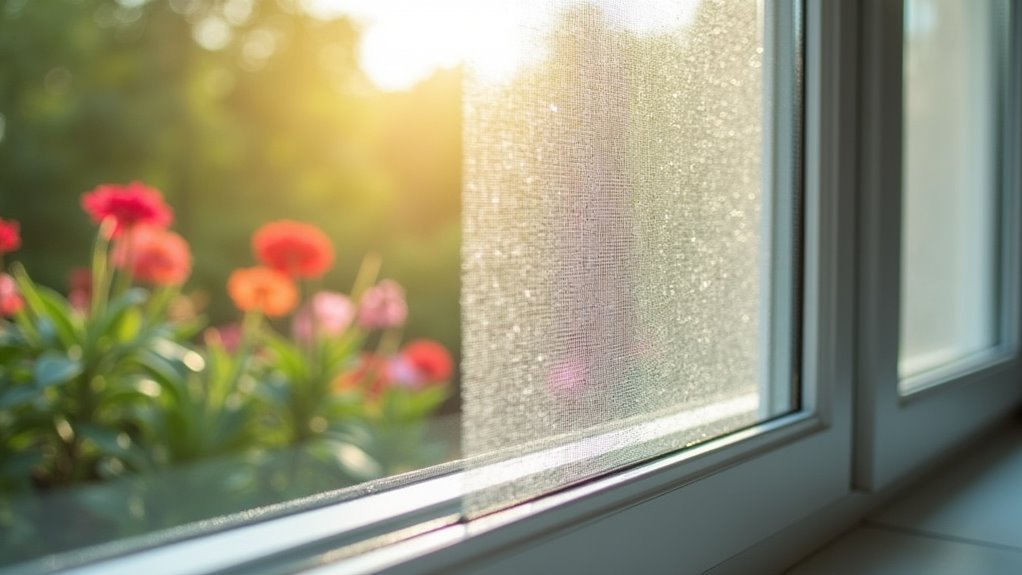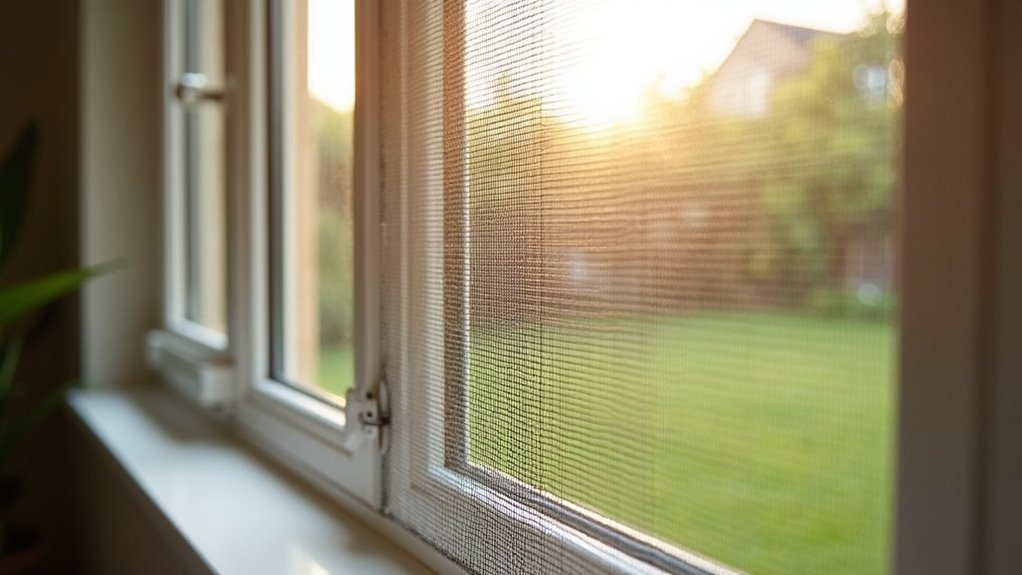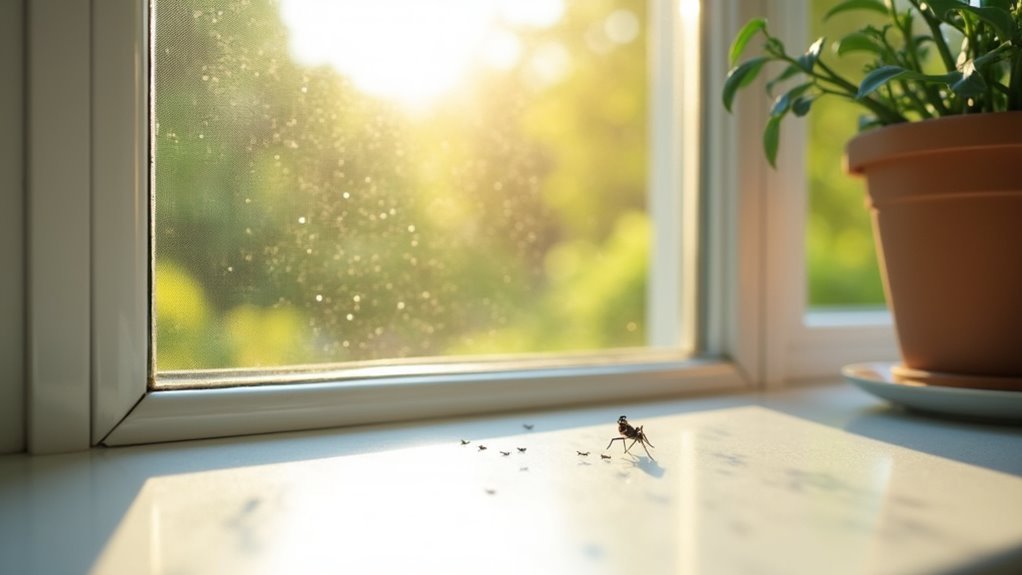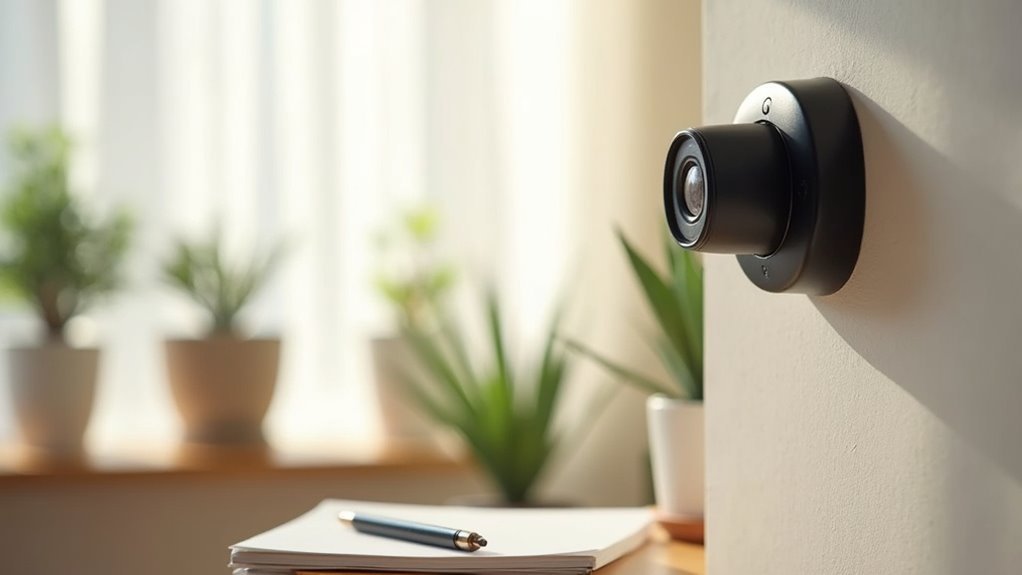You’ll need fine mesh aluminum screens that block 98% of roaches and other pests, combined with quality weather stripping and silicone caulk to seal gaps as small as 1/4 inch. Install screens tightly against frames, apply natural deterrent coatings like Slick Barrier to create slippery surfaces, and maintain everything with annual inspections and touch-ups. This multi-layered approach transforms windows into impenetrable barriers when you understand the specific techniques that guarantee lasting protection.
Essential Window Screen Types and Mesh Selection for Maximum Pest Protection

When protecting your home from unwanted pests, selecting the right window screen becomes your first line of defense. Standard window screens effectively block most flying insects while maintaining proper airflow throughout your home.
However, fine mesh screens offer superior pest prevention against smaller invaders that slip through regular screening. For maximum pest control, you’ll want aluminum window screens due to their exceptional durability and 98% effectiveness against roach species.
When dealing with specific pest species like B. germanica and Periplaneta, micro-mesh screens provide the tightest filtering to prevent even tiny insects from entering.
Consider your home’s particular vulnerability to unwanted pests when choosing mesh density. Tighter screening proves essential for thorough protection, while overlapping installation techniques minimize gaps that compromise your barrier’s effectiveness.
Weather Stripping and Sealant Solutions to Eliminate Window Entry Points
Even the finest window screens won’t protect your home if gaps around the window frame create easy entry points for determined pests.
Weather stripping creates an essential physical barrier by sealing spaces that insects exploit to infiltrate your living areas. You’ll need quality sealants like silicone caulk to fill openings as small as 1/4 inch—tiny gaps and cracks that seem insignificant but serve as pest highways.
Regular inspection and maintenance of your sealing materials is vital for effective pest management. Damaged weather stripping dramatically increases vulnerability to bug intrusions.
Consider upgrading to advanced materials like foam tape or V-strips for superior protection. User-friendly adhesive sealants such as InstaTrim offer cleaner application than traditional caulking while maintaining professional-grade sealing performance against unwanted invaders.
Physical Installation Techniques for Long-Lasting Window Barriers

Quality sealing materials mean nothing without proper installation techniques that guarantee your window barriers perform effectively for years to come.
You’ll need to make sure your mesh fits tightly against window frames, eliminating gaps that allow different pest species inside. Start by measuring precisely and cutting materials slightly larger than needed, then trim for perfect fit.
When installing screens, stretch the mesh evenly to prevent sagging that creates entry points. Apply firm, consistent pressure when positioning weather stripping around sashes. Use overlapping techniques with dual-layer screening for enhanced protection.
Regularly inspect your barrier system and immediately address any wear or damage. These installation tips help you protect your home by preventing pests from entering through compromised window seals.
Natural Deterrent Coatings and Surface Treatments for Window Frames
Natural deterrent coatings offer an innovative approach to pest control that transforms your window frames into slippery barriers crawling insects can’t navigate. Products like Slick Barrier create non-stick surfaces that prevent crawling pests from climbing, effectively blocking unwanted visitors without chemicals.
| Surface Type | Application Method |
|---|---|
| Wood frames | Vertical brush strokes |
| Brick surfaces | Roller application |
| Stucco exterior | Spray technique |
| Bottom of doors | Horizontal coverage |
| Metal frames | Thin coat brushing |
These coatings form a seamless barrier on various materials while remaining safe for your living environment once dried. They support Integrated Pest Management strategies through sustainable, non-toxic protection. You’ll need touch-ups every 1-2 years depending on weather exposure, but regular maintenance guarantees continuous effectiveness against pest invasions.
Maintenance Strategies to Keep Window Pest Barriers Functioning Year-Round

Consistency becomes your greatest ally when maintaining window pest barriers throughout changing seasons and weather conditions. Your first line of defense requires regular inspection of window screens for tears, holes, or damage that compromise effectiveness against pest entry.
You’ll want to clean window frames and tracks thoroughly, ensuring proper seals since dirt and debris weaken weather stripping functionality against insects like ants and other invaders.
Apply fresh weather stripping annually around windows, selecting materials that create snug fits without gaps. Check caulking and sealants around window edges twice yearly, reapplying where necessary to seal developing cracks.
Don’t forget door sweeps as part of your thorough barrier system. Rotate and repair screens using fine mesh options for enhanced protection against smaller pests, ensuring secure fits that eliminate potential entry points.
Frequently Asked Questions
Does Slick Barrier Actually Work?
Yes, Slick Barrier actually works by creating a slippery surface that prevents crawling pests from climbing vertical surfaces. You’ll need to reapply every 1-2 years, but users report successful pest prevention results.
How Do You Keep Pests Out by Getting Rid of Space Under and Around Doors?
Install door sweeps and weatherstripping to seal gaps under and around doors. Use brush sweeps for insects, vinyl for rodents. Fill larger holes with steel wool, then caulk remaining spaces for complete pest exclusion.
Does Pestie Work on Flies?
Yes, Pestie works effectively on flies. You’ll see a significant reduction in fly activity when you apply it to window screens and surrounding areas. It creates a barrier that disrupts flies’ ability to enter.
In Summary
You’ve now got the essential tools to create an impenetrable window barrier system. Remember, you’ll need to combine multiple approaches—quality screens, proper sealing, correct installation, natural deterrents, and consistent maintenance—for maximum effectiveness. Don’t skip the regular inspections, as small gaps can quickly become major entry points. When you implement these strategies consistently, you’ll dramatically reduce pest intrusions and enjoy a more comfortable, pest-free home environment year-round.





Leave a Reply